|
New Orleans Jazz Fest feature
story
BMF receptions for Jazz in June
Photo Gallery
Benny Powell Memorial
NJO, Lied Center and Brownville schedules
Charles Mingus and
the Racial Mountain
Tomfoolery
|
July 2010
Feature Articles
Music news, interviews, memorials, opinion |
|
Feature Story
New Orleans continues
to offer the best
in musical heritage,
food and decadent fun
By Tom Ineck
NEW
ORLEANS—After 15 years, I returned to the New Orleans Jazz and Heritage
Festival with mixed emotions and more than a little trepidation. After
all, the city and I had changed considerably since 1995.
![French Quarter streetscape features historic wrought-iron architecture and neon-lit bars. [Photo by Tom Ineck]](media/710NOJFQuarter.jpg) Nearly
five years ago, Hurricane Katrina and subsequent flooding inundated 80
percent of the city and rendered whole neighborhoods uninhabitable. The
Big Easy lost many of its residents to other parts of the country,
including the musicians who made New Orleans so unique. Some may never
return. The total urban population shrunk from a pre-Katrina high of
450,000 to less than half that before rebounding to an estimated
350,000. Now, the citizens who remain must deal with a growing oil spill
wreaking havoc with the Gulf of Mexico’s ecological system and
endangering the vital fishing and tourism industries. Nearly
five years ago, Hurricane Katrina and subsequent flooding inundated 80
percent of the city and rendered whole neighborhoods uninhabitable. The
Big Easy lost many of its residents to other parts of the country,
including the musicians who made New Orleans so unique. Some may never
return. The total urban population shrunk from a pre-Katrina high of
450,000 to less than half that before rebounding to an estimated
350,000. Now, the citizens who remain must deal with a growing oil spill
wreaking havoc with the Gulf of Mexico’s ecological system and
endangering the vital fishing and tourism industries.
Since I
last attended Jazz Fest, I have grown older, slower and less patient
with large outdoor crowds. I have less energy to fight my way to the
front of the stage, and my knees are too weak to stand for hours in the
heat and humidity. In short, I’m too old for Woodstock revisited. But my
desire for good music—of all kinds—remains strong. Fortunately, the
festival still gives the open-minded,
![Antoine's Restaurant is one of New Orleans' oldest eatiing establishments. [Photo by Tom Ineck]](media/710NOJFAntoine.jpg) eclectic
music fan a dozen stages to choose from, and the music sounds just as
good while seated under a tent as it does standing in an open field. If
you balance the two experiences, you can enjoy both and not suffer early
burn out. eclectic
music fan a dozen stages to choose from, and the music sounds just as
good while seated under a tent as it does standing in an open field. If
you balance the two experiences, you can enjoy both and not suffer early
burn out.
Separate
stages devoted to different styles of music are positioned throughout
the 145-acre site, the infield of the mid-city Fair Grounds Race Course.
Some artists are gathered under the festival’s broad stylistic umbrella
for their star power alone, but most are linked in some way to the
Crescent City’s unique musical heritage.
For
example, the 41st annual festival (April 23-May 2) featured
Celtic soul icon Van Morrison, jam rockers Widespread Panic, folk
veterans Simon & Garfunkel, grunge rock favorites Pearl Jam, the
ubiquitous British chameleon Elvis Costello, comic Steve Martin doing
his bluegrass thing, and fusion guitar god Jeff Beck. Among the no-shows
was Aretha Franklin, who was replaced by Earth, Wind and Fire. These are
the celebrated names that ensure that Jazz Fest will remain solvent as
it continues to attract hundreds of thousands of people from around the
world.
![People line up for traditional New Orleans cuisine. [Photo by Tom Ineck]](media/710NOJFFood.jpg) For
the $45 daily admission, the most fanatical of fans scurry from stage to
stage to catch the big acts from 11 a.m. to 7 p.m. each of seven days
spread over two weekends, often standing for hours and settling for a
glimpse of their favorite stars on the huge video screens set up at the
two largest outdoor venues. Those of us seeking a more intimate
relationship with the music historically connected to New Orleans seek
refuge in the smaller tents, where we can sit and enjoy the sounds of
traditional jazz, progressive jazz, blues, funk, soul, or gospel.
Smaller outdoor stages offer Cajun and zydeco music and the spectacle of
Mardi Gras Indians dancing in their beaded and feathered finery and
parading through the grounds. For
the $45 daily admission, the most fanatical of fans scurry from stage to
stage to catch the big acts from 11 a.m. to 7 p.m. each of seven days
spread over two weekends, often standing for hours and settling for a
glimpse of their favorite stars on the huge video screens set up at the
two largest outdoor venues. Those of us seeking a more intimate
relationship with the music historically connected to New Orleans seek
refuge in the smaller tents, where we can sit and enjoy the sounds of
traditional jazz, progressive jazz, blues, funk, soul, or gospel.
Smaller outdoor stages offer Cajun and zydeco music and the spectacle of
Mardi Gras Indians dancing in their beaded and feathered finery and
parading through the grounds.
These are
the traditions on which the city’s cultural reputation is based, and
they continue to resonate. Whether the artists are the Neville Brothers,
Ellis
![My cousin Jerry Siefken (left) is among the second-liners in the Economy Hall tent. [Photo by Tom Ineck]](media/710NOJFJerry2.jpg) Marsalis,
C.J. Chenier, the Dirty Dozen, BeauSoleil and Allen Toussaint, or
lesser-known practitioners of the art, they represent a phenomenon more
than a century in the making. Marsalis,
C.J. Chenier, the Dirty Dozen, BeauSoleil and Allen Toussaint, or
lesser-known practitioners of the art, they represent a phenomenon more
than a century in the making.
So it was
with much anticipation and a little anxiety that my wife, Mary Jane
Gruba, and I returned to Jazz Fest after a 15-year absence. We arrived
in New Orleans April 28 equipped with tickets for the four-day second
weekend, a little cash for the rows of vendors offering authentic Cajun,
Creole and international cuisine, light clothing with some reliable
walking shoes and hats and plenty of sunscreen. My cousin Jerry Siefken,
a local resident and
![Singer Dee Dee Bridgewater is interviewed at Music Heritage Stage. [Photo by Tom Ineck]](media/710NOJFDeeDee1.jpg) Jazz
Fest veteran, loaned us a couple of compact folding chairs, which we
never used. Typically, the weather varied from warm and sunny the first
day to comfortably cloudy the second and third days and persistently
rainy the final day. Jazz
Fest veteran, loaned us a couple of compact folding chairs, which we
never used. Typically, the weather varied from warm and sunny the first
day to comfortably cloudy the second and third days and persistently
rainy the final day.
With a
detailed, gridded music schedule, we planned our days in advance, but
prepared for last-minute changes—the best way to enjoy a relatively
stress-free Jazz Fest experience. For example, on Thursday we took in
the distinctly New Orleans funk sounds of Kirk Joseph’s Backyard Groove
and Ivan Neville’s Dumpstaphunk, then retired to the indoor Music
Heritage Stage for an interview with singer Dee Dee Bridgewater before
fighting the swarming crowds to enjoy a hilarious performance by Steve
Martin, sitting in on banjo with bluegrass virtuosi the Steep Canyon
Rangers. We ended the day at the WWOZ Jazz Tent for Bridgewater’s
stunning celebration of Billie Holiday.
![The crowd waits for Jeff Beck to take the stage. [Photo by Tom Ineck]](media/710NOJFBeck9.jpg) Among
other memorable moments that weekend were sets by pianist-composer Allen
Toussaint’s Jazzity Project, Delfeayo Marsalis and the Uptown Jazz
Orchestra, Brian Blade and the Fellowship Band, Astral Project, the New
Leviathan Oriental Foxtrot Orchestra, Ellis Marsalis, and Steve Riley &
the Mamou Playboys. During a rainy Sunday morning, moving performances
by several soulful choirs provided a much-needed respite under the
gospel tent. And, after 40 years of hero worship I realized a dream by
witnessing Jeff Beck in all his six-stringed glory. Some of these
performances are reviewed in more detail elsewhere on the BMF website
and in the BMF newsletter. Among
other memorable moments that weekend were sets by pianist-composer Allen
Toussaint’s Jazzity Project, Delfeayo Marsalis and the Uptown Jazz
Orchestra, Brian Blade and the Fellowship Band, Astral Project, the New
Leviathan Oriental Foxtrot Orchestra, Ellis Marsalis, and Steve Riley &
the Mamou Playboys. During a rainy Sunday morning, moving performances
by several soulful choirs provided a much-needed respite under the
gospel tent. And, after 40 years of hero worship I realized a dream by
witnessing Jeff Beck in all his six-stringed glory. Some of these
performances are reviewed in more detail elsewhere on the BMF website
and in the BMF newsletter.
![St. Louis Cathedral in Jackson Square [Photo by Tom Ineck]](media/710NOJFCathedral.jpg) The
precious hours before and after Jazz Fest should always be spent
sampling a few of New Orleans other highlights, especially those in the
pedestrian-friendly French Quarter. Stroll through Jackson Square to see
St. Louis Cathedral in the morning sunlight before stopping for café au
lait and beignets (doughnut-like pastries smothered in powdered sugar)
at Café du Monde, also a good place for celebrity sightings. On the day
we visited, actress Maggie Gyllenhaal and her three-year-old daughter
were there. The
precious hours before and after Jazz Fest should always be spent
sampling a few of New Orleans other highlights, especially those in the
pedestrian-friendly French Quarter. Stroll through Jackson Square to see
St. Louis Cathedral in the morning sunlight before stopping for café au
lait and beignets (doughnut-like pastries smothered in powdered sugar)
at Café du Monde, also a good place for celebrity sightings. On the day
we visited, actress Maggie Gyllenhaal and her three-year-old daughter
were there.
For an
early lunch, we recommend the deli at Central Grocery, home of the
classic muffuletta sandwich, a large helping of Italian meats and
cheeses dressed with a special olive salad inside a round loaf of
focaccia
![Mary Jane Gruba enjoys a beignet and cafe au lait at Cafe du Monde. [Photo by Tom Ineck]](media/710NOJFDuMondeMJ.jpg) bread.
A leisurely stroll through the Quarter offers a combination of
old-country streetscapes, quaint shops, beautiful wrought-iron
architecture, eccentric street musicians and pressurized water trucks
removing the dregs of the night before. bread.
A leisurely stroll through the Quarter offers a combination of
old-country streetscapes, quaint shops, beautiful wrought-iron
architecture, eccentric street musicians and pressurized water trucks
removing the dregs of the night before.
Evenings
should include dinner at one of the many fine restaurants in or near the
Quarter. During our stay, we had excellent meals at Tujague’s, the Bon
Ton Café and the Palace Café. Expect to spend $80 to $150 for two,
depending on the quality and quantity of the wine. For a special treat,
visit one of the city’s night spots for a music experience much more
relaxed than a day at Jazz Fest. This year, we returned to one of our
favorite haunts, the Snug Harbor jazz club, for a Saturday evening
performance by New Orleans jazz pianist Henry Butler, fronting a stellar
![The Bon Ton Cafe in the Central Business District [Photo by Tom Ineck]](media/710NOJFBonTon.jpg) quartet.
Among the regular performers at Snug Harbor are R&B singer Charmaine
Neville, Marsalis patriarch Ellis and Astral Project. Based on previous
visits, we also recommend Tipitina’s and the Rock ‘n’ Bowl. quartet.
Among the regular performers at Snug Harbor are R&B singer Charmaine
Neville, Marsalis patriarch Ellis and Astral Project. Based on previous
visits, we also recommend Tipitina’s and the Rock ‘n’ Bowl.
Jazz Fest’s
popularity makes careful planning essential. Consider booking a hotel or
bed-and-breakfast room six months in advance. Expect to pay at least
$200 a night for a decent room in the Quarter. Stay just outside the
Quarter, spend less and still get around on foot, rented bicycle,
streetcar or other public transportation. Don’t rent a car!
For the
2011 edition, some music artists will be announced later this year or
early next year, but detailed schedules are not available until about a
month before the festival begins. Some 4,000 musicians perform each year
during Jazz Fest.
top |
|
BMF
Receptions
BMF celebrates another Jazz in June
series |
|
By Grace
Sankey-Berman
LINCOLN,
Neb.—I had the pleasure of hosting the Berman Music Foundation board
members in a reception at our office after our annual meeting June 15.
In the
![BMF colleagues meet June 15 at Lazlo's [Photo by Laura Hansen]](media/710Receptions1.jpg) past our meetings had been scheduled in the winter, which
sometime presented travel challenges for board members that came from
out of town. Also, we thought it would be fun for those members to
experience the great Lincoln tradition that is Jazz in June. past our meetings had been scheduled in the winter, which
sometime presented travel challenges for board members that came from
out of town. Also, we thought it would be fun for those members to
experience the great Lincoln tradition that is Jazz in June.
After the
meeting we all went to the Sheldon Sculpture Garden where Kansas City
songstress Angela Hagenbach was to perform. It turned out to be a
beautiful evening for great jazz. Angela and her band, along with one of
my favorite pianists, Roger Wilder, serenaded us with familiar and
always pleasing standards like “Summertime,” and she also featured some
songs from her own recordings. It was the perfect way to relax after a
busy day.
Then we
headed to the BMF office for a reception. It was nice to catch up with
Dan Demuth, who despite storm, snow or sleet unfailingly makes it to the
annual board meeting from his home in Colorado. I always look forward to
spending time with Wade Wright of San Francisco, who is the
longest-serving board member. We have the best conversations on just
about any subject. Russ Dantzler came for the meeting from New York City,
despite his very busy
![Catherine Sinclair and Kay Davis [Photo by Grace Sankey-Berman]](media/710Receptions3.jpg) summer schedule. I can’t wait to make it back to
the city because he is the best host. Even though bassist Gerald Spaits
had a gig that same night in Kansas City, he made the 3½-hour drive to
Lincoln for the meeting and drove back right after. summer schedule. I can’t wait to make it back to
the city because he is the best host. Even though bassist Gerald Spaits
had a gig that same night in Kansas City, he made the 3½-hour drive to
Lincoln for the meeting and drove back right after.
We are
lucky and grateful to be working with such great friends, especially Kay
Davis. She worked with Butch for many years and even though she has
retired to
Arkansas, she continues to make the annual trip back to Lincoln for the board meeting. Kay was kind enough to spend a few days
with me while she was here. Our time together is always fun and goes by
too fast. Kay is recovering from a bout with pneumonia and we wish her a
speedy recovery.
BMF was
happy to host two more receptions during this year’s Jazz in June
series. Jeff Newell and his New-Trad Octet were great fun to hang out
with after their June 22 concert, and guitarist Jerry Hahn graciously
joined us after a great performance June 29, the final concert of the
season. Thanks go to Martha Florence, Laurie J. Sipple and all the Jazz
in June volunteers who were able to join us. I would like to extend my
appreciation to Ruthann Nahorny for always being there, and to Laura
Hansen. Thanks for all your help.
top |
|
Photo Gallery
BMF friends gather to visit at BMF
offices |
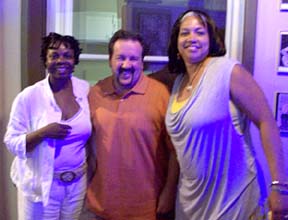 |
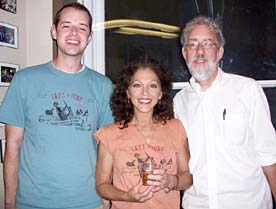 |
|
Grace Sankey-Berman, Tony Rager and Martha Florence |
Brian Muhlbach, Laurie Sipple and Tom Ineck |
|
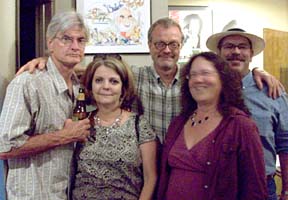 |
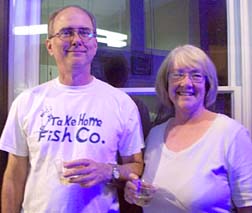 |
|
Friends include Jim and Kay Wunderlich, Russ Dantzler,
Cynthia Taylor and Greg Harm |
Ed and Loretta Love |
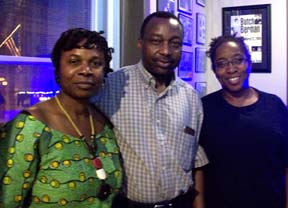 |
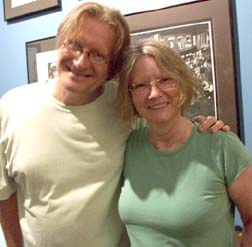 |
|
Grace Sankey-Berman, Jimmy Akpan and Adrienne
Pettigrew |
Brad Krieger and Cathy Patterson |
|
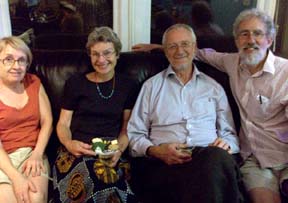 |
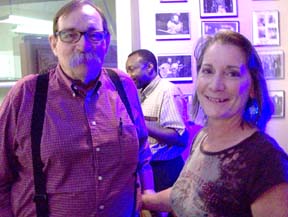 |
|
Mary Jane Gruba, Jane and Peter Reinkordt
and Tom Ineck |
Wade Wright and Ruthann Nahorny |
|
|
Memorial
Benny Powell's passing reunites trio of
friends |
|
By Tom Ineck
LINCOLN, Neb.—As Berman Music
Foundation consultant Russ Dantzler
noted, a trio of BMF friends who also
were frequent collaborators were
reunited with the June 26 death of
trombonist Benny Powell at age 80.
Preceding Powell were bassist Earl May
in January 2008 (also at 80), then Jane
Jarvis in January of this year at age
94.
![Butch Berman and Benny Powell in 1999 [File Photo]](media/710ButchPowell.jpg) The
three shared the stage here on Oct. 8,
1999, at the Cornhusker Hotel, a
fundraiser for the Lincoln Seniors
Foundation that was partially funded by
the BMF. “Lifelong Living and All That
Jazz” was the theme that night, and it
proved to be a valid philosophy for
Powell, Jarvis, and May. The trio at
that time had already lived a combined
225 years, and much of that time was
spent performing the music they loved. The
three shared the stage here on Oct. 8,
1999, at the Cornhusker Hotel, a
fundraiser for the Lincoln Seniors
Foundation that was partially funded by
the BMF. “Lifelong Living and All That
Jazz” was the theme that night, and it
proved to be a valid philosophy for
Powell, Jarvis, and May. The trio at
that time had already lived a combined
225 years, and much of that time was
spent performing the music they loved.
When the trio received a standing
ovation before playing the first note,
Powell quipped, “We chose the right time
to become older persons.” As I later
wrote, the performance “joyfully
illustrated that creativity need not be
stifled by longevity. Indeed, it offered
ample evidence that the creative arts
can help prolong a youthful approach to
life.”
The trombonist was also a fine vocalist
of great sensitivity. That night in
1999, he sang the Jarvis composition
“I'll Make it This Time,” a tune the
pianist wrote for a Broadway production.
Later in the evening, Powell used his
trombone to state the melody of the
Jarvis-penned tearjerker “Here Lies My
Love,” another tune written for the
stage. Powell summed up the poignancy of
the evening (and of aging) in his vocal
rendering of “For All We Know.”
Born in New Orleans, March 1, 1930,
Powell was admired equally as a
performer and an educator. He attended
Alabama State Teachers College before
going on the road with the King Kolax
band. He also worked with Ernie Fields
and Lionel Hampton until joining the
Basie band in 1951. He remained with
Basie for 12 years, winning DownBeat
magazine’s critics’ poll in 1956.
After leaving Basie, Powell was became a
popular studio musician, making many
small group dates and big band sessions.
He played in the Broadway pit orchestra
for “Funny Girl” in 1964. As an
occasional actor, he had a small role in
“A Man Called Adam” (1966), starring
Sammy Davis Jr., and played in the
onscreen Basie band in “Blazing Saddles”
in 1974. Powell’s adventurous sound
bridged the gap between swing, bop and
world music, later working with Abdullah
Ibrahim, Randy Weston and John Carter.
As an educator, Powell helped to direct
the Jazzmobile program, which brought
jazz to disadvantaged areas of New York
City. He also taught at the New School
University until the close of his
career. He was named a National
Endowment for the Arts Jazz Master.
Powell died at Roosevelt Hospital in New
York City, apparently of a heart attack,
while recovering from successful spinal
surgery. Three times divorced, Powell is
survived by his daughter, Demetra, and
grandchildren, Faith and Kyle, and by
his sister, Elizabeth.
A traditional jazz service was held July
12 at St. Peter’s Church in New York
City. Among those who performed were
Randy Weston and African Rhythms and
Nextep, a group featuring saxophonist
Frank Wess (and the group with whom Powell
recorded a 2008 release). One of
Powell’s nieces performed a classical
piece on violin. Weston also gave a
moving nine-minute eulogy in honor of
his longtime friend and bandmate.
“Benny Powell represents the essence of
our music,” Weston said. “Our music is
more than notes and scales. It’s more
than paper and gigs. It’s spirit, and
musicians have been given the gift of
spirit.”
top |
|
NJO, Lied and Brownville concert
series |
|
By Tom Ineck
LINCOLN, Neb.—Jazz and other great
American music are on the bill in coming
months at various area venues. Mark your
calendars and support live music!
![Wayne Bergeron [Courtesy Photo]](media/710Bergeron.jpg) After
a year of financial struggle,
reassessment and retrenchment in which
most of its concerts featured members of
the band the Nebraska Jazz Orchestra is
back with one of its strongest seasons
in years. It all begins Oct. 15 at the
Lied Center for Performing Arts, where
the NJO again will feature famed
trumpeter Wayne Bergeron, who was
in less than stellar condition when he
appeared with the band last October.
Having just suffered a lip injury that
curtailed his playing, he had to rely on
able protégé Willie Murillo. Rest
assured, Bergeron fans will hear from
the man himself at the Lied. After
a year of financial struggle,
reassessment and retrenchment in which
most of its concerts featured members of
the band the Nebraska Jazz Orchestra is
back with one of its strongest seasons
in years. It all begins Oct. 15 at the
Lied Center for Performing Arts, where
the NJO again will feature famed
trumpeter Wayne Bergeron, who was
in less than stellar condition when he
appeared with the band last October.
Having just suffered a lip injury that
curtailed his playing, he had to rely on
able protégé Willie Murillo. Rest
assured, Bergeron fans will hear from
the man himself at the Lied.
On Dec. 14, local actress and singer
Melissa Lewis will join the NJO for
its annual Christmas concert at the
Cornhusker Marriott. Well known for her
skills on the theatrical stage, Lewis is
also garnering raves as a vocalist of
formidable technique and crowd-pleasing
showmanship.
![Scott Robinson and contrabass saxophone [Courtesy Photo]](media/710Robinson.jpg) Multi-instrumentalist
Scott Robinson will appear as
guest soloist with the NJO Feb. 18 at
the Marriott. A 1981 graduate of the
Berklee College of Music in Boston, he
joined its staff the next year to become
the youngest faculty member in the
school’s history. He stayed until 1984,
when he moved to New York City, later
working with Buck Clayton, Lionel
Hampton, and Paquito D’Rivera. He has
also written film music and has been
awarded four fellowships by the National
Endowment for the Arts. Among the
unusual reed instruments he plays are
the contrabass saxophone and C-Melody
saxophone. Multi-instrumentalist
Scott Robinson will appear as
guest soloist with the NJO Feb. 18 at
the Marriott. A 1981 graduate of the
Berklee College of Music in Boston, he
joined its staff the next year to become
the youngest faculty member in the
school’s history. He stayed until 1984,
when he moved to New York City, later
working with Buck Clayton, Lionel
Hampton, and Paquito D’Rivera. He has
also written film music and has been
awarded four fellowships by the National
Endowment for the Arts. Among the
unusual reed instruments he plays are
the contrabass saxophone and C-Melody
saxophone.
On April 26 veteran NJO bassist Andy
Hall will be featured in “Ace of
Bass,” a program devoted to the music of
Jaco Pastorius as arranged for big band
by Peter Graves, whose band Pastorius
played with when still quite young.
Graves has produced two all-star CD
collections of his big-band arrangements
of Pastorius tunes, 2003’s “Word of
Mouth Revisited” and 2006’s “The Word is
![Terence Blanchard [Courtesy Photo]](media/710Blanchard.jpg) Out!”
Hall’s aggressive, virtuosic bass style,
which owes much to Pastorius, should be
ideal for these challenging tunes. Out!”
Hall’s aggressive, virtuosic bass style,
which owes much to Pastorius, should be
ideal for these challenging tunes.
In addition to the NJO appearance Oct.
15, the upcoming Lied Center season
includes several other notable jazz
concerts. Branford Marsalis and
Terence Blanchard will team up
for a Feb. 25 performance that brings
together two New Orleans natives who are
among the leaders in mainstream jazz of
the 21st century.
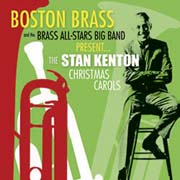
A concert Dec. 11 will feature the
Boston Brass and Brass All-Stars Big
Band in a holiday tribute, with 14
horns and a rhythm section performing
the famous Stan Kenton Christmas carols
and other holiday hits. The ensemble’s
recording of the Kenton pieces was
released in 2005.
![Trombonist Bill Hughes leads the Count Basie Orchestra [Courtesy Photo]](media/710Basie1.jpg) More
than 26 years after the death of its
founder, the legendary Count Basie
Orchestra continues to thrill
audiences with its unique style of
blues-based Kansas City swing. The band
will appear March 18 at the Lied. Now
directed by trombonist Bill Hughes, the
band has never stopped touring and
recording. Its most recent release is
“Basie Is Back,” recorded live in Japan
in 2005. More
than 26 years after the death of its
founder, the legendary Count Basie
Orchestra continues to thrill
audiences with its unique style of
blues-based Kansas City swing. The band
will appear March 18 at the Lied. Now
directed by trombonist Bill Hughes, the
band has never stopped touring and
recording. Its most recent release is
“Basie Is Back,” recorded live in Japan
in 2005.
Down the road about 80 miles, the
Brownville Concert Hall continues its 20th
anniversary season with additional
![KT Sullivan and Mark Nadler [Courtesy Photo]](media/710SullivanNadler.jpg) performances
booked in Lincoln and Omaha. The
“Cavalcade of Cabaret” will feature
world-class cabaret singer KT
Sullivan and singer-pianist Mark
Nadler in a series of concerts
beginning Aug. 13 in Brownville and
continuing Aug. 14 at the Omaha
Community Playhouse. A month later, they
return to the area for performances
Sept. 9 at the Rococo Theater in Lincoln
and Sept. 10-12 in Brownville. performances
booked in Lincoln and Omaha. The
“Cavalcade of Cabaret” will feature
world-class cabaret singer KT
Sullivan and singer-pianist Mark
Nadler in a series of concerts
beginning Aug. 13 in Brownville and
continuing Aug. 14 at the Omaha
Community Playhouse. A month later, they
return to the area for performances
Sept. 9 at the Rococo Theater in Lincoln
and Sept. 10-12 in Brownville.
If you want to venture still further
down the road, the Folly Theater in
Kansas City continues another excellent
jazz concert series with performances
Sept. 25 by The Bad Plus, Oct. 14
by the Dave Brubeck Quartet, Dec.
10 by singer Sachal Vasandani,
Jan. 15 by the Earl Klugh Quartet,
April 2 by Joe Lovano Us Five,
and May 7 by Karrin Allyson.
top |
|
Essay
Charles Mingus and the Racial Mountain |
|
The following essay was written for a class in African-American
literature that I took at the University of
Nebraska-Lincoln during the spring 2010 semester. It was a mid-term paper required by course instructor Megan Peabody. Since it
deals with the music and personal struggle of Charles Mingus, I
thought it appropriate for BMF readers. I also liked the idea of
recycling the essay for a broader audience. I have altered the scholarly
formatting and page citations for a more journalistic approach.
By Tom
Ineck
“Our
folk music, having achieved world-wide fame, offers itself to the genius
of the great individual American composer who is to come.”
![Langston Hughes [Courtesy Photo]](media/710Hughes.jpg) When
this prophetic statement by Langston Hughes first appeared in his essay
“The Negro Artist and the Racial Mountain” in 1926, jazz was still in
its infancy. Its earliest recordings were less than 10 years old, and
its most influential artists—Louis Armstrong, Jelly Roll Morton, Duke
Ellington—were just beginning to build a popular following at dance
clubs and concert halls in Chicago, New York City and abroad. But in the
ethnic idiosyncrasies of the music’s melodies, harmonies, rhythms and
lyrics, Hughes already hears the free expression of his race as it draws
material and inspiration from every aspect of life and transforms it
into art that speaks to everyone. Since Hughes sounded his clarion call
for black artists to draw on their own lives and the history of African
American culture for inspiration, generations of black musicians have
heeded the message. They find ample material in the spirituals of their
religious practices, in the unfettered joy of their roadhouses, even in
the drudgery of their workaday worlds. When
this prophetic statement by Langston Hughes first appeared in his essay
“The Negro Artist and the Racial Mountain” in 1926, jazz was still in
its infancy. Its earliest recordings were less than 10 years old, and
its most influential artists—Louis Armstrong, Jelly Roll Morton, Duke
Ellington—were just beginning to build a popular following at dance
clubs and concert halls in Chicago, New York City and abroad. But in the
ethnic idiosyncrasies of the music’s melodies, harmonies, rhythms and
lyrics, Hughes already hears the free expression of his race as it draws
material and inspiration from every aspect of life and transforms it
into art that speaks to everyone. Since Hughes sounded his clarion call
for black artists to draw on their own lives and the history of African
American culture for inspiration, generations of black musicians have
heeded the message. They find ample material in the spirituals of their
religious practices, in the unfettered joy of their roadhouses, even in
the drudgery of their workaday worlds.
![Charles Mingus [Courtesy Photo]](media/710Mingus.jpg) Composer,
bandleader and bassist Charles Mingus (1922-1979) is one of the most
vivid examples of a black artist who draws on his own experiences in the
context of African American history and culture and creates potent
music. He combines the power of the blues, work songs, and spirituals
with the complex rhythms of African folk drumming and black dance forms.
He occasionally orchestrates his larger ensembles in the manner of
European symphonic music, but always in a style that is distinctly—even
defiantly—his own, an attribute that Hughes would have appreciated. By
looking at just two Mingus recordings—"Blues and Roots" from 1960 and
"The Black Saint and the Sinner Lady" from 1963—we can form a portrait
of the artist and the impulses that stimulated his artistic vision,
impulses rooted in the African American experience of which Hughes
wrote. Original liner notes and re-appraisals by Mingus and others
reveal an artist who struggles with racism and acceptance, emotional
pain and depression, but always strives to create music that is genuine. Composer,
bandleader and bassist Charles Mingus (1922-1979) is one of the most
vivid examples of a black artist who draws on his own experiences in the
context of African American history and culture and creates potent
music. He combines the power of the blues, work songs, and spirituals
with the complex rhythms of African folk drumming and black dance forms.
He occasionally orchestrates his larger ensembles in the manner of
European symphonic music, but always in a style that is distinctly—even
defiantly—his own, an attribute that Hughes would have appreciated. By
looking at just two Mingus recordings—"Blues and Roots" from 1960 and
"The Black Saint and the Sinner Lady" from 1963—we can form a portrait
of the artist and the impulses that stimulated his artistic vision,
impulses rooted in the African American experience of which Hughes
wrote. Original liner notes and re-appraisals by Mingus and others
reveal an artist who struggles with racism and acceptance, emotional
pain and depression, but always strives to create music that is genuine.
A man
sensitive to racial discrimination, as well as the larger issues of
human rights and world peace, Mingus tells jazz critic Nat Hentoff,
“It’s not only a question of color anymore. It’s getting deeper than
that. I mean it’s getting more and more difficult for a man or woman to
just love. People are getting so fragmented, and part of that is fewer
and fewer people are making a real effort anymore to find exactly who
they are.” ("Blues and Roots" liner notes). He epitomizes the black
artist whom Hughes envisions when he writes, “jazz to me is one of the
inherent expressions of Negro life in America; the eternal tom-tom
beating in the Negro soul—the tom-tom of revolt against weariness in a
white world, a world of subway trains, and work, work, work; the tom-tom
of joy and laughter, and pain swallowed with a smile.” The composer is
brutally honest as he tells Hentoff, “music […] is, or was, a language
of
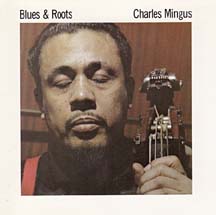 the
emotions. If someone has been escaping reality, I don’t expect him to
dig my music…. My music is alive and it’s about the living and the dead,
about good and evil. It’s angry, yet it’s real because it knows it’s
angry.” the
emotions. If someone has been escaping reality, I don’t expect him to
dig my music…. My music is alive and it’s about the living and the dead,
about good and evil. It’s angry, yet it’s real because it knows it’s
angry.”
Hughes
singles out “the low-down folks, the so-called common element” as those
most likely to create genuine art from everyday experience, including
religious experience. “Their joy runs, bang! into ecstasy. Their
religion soars to a shout…. These common people are not afraid of
spirituals, as for a long time their more intellectual brethren were,
and jazz is their child.” As Hughes urges, Mingus taps his spiritual
roots for the fiery gospel tune “Wednesday Night Prayer Meeting,” which
the composer describes as “church music. I heard this as a child when I
went to meetings with my mother. The congregation gives their
testimonial before the Lord, they confess their sins and sing and shout
and do a little Holy Rolling.” ("Blues and Roots" liner notes)
Hentoff
helps us understand Mingus’ musical influences, writing in the liner
notes to "Blues and Roots," “Mingus sure knew and felt his roots. He had
played, after all, with the whole range of jazz—from Kid Ory to Charlie
Parker. He knew the entire language—from the inside.” Most blues tunes
are simple constructions of just three predominant chords repeated over
and over, allowing jazz soloists to freely express themselves with
infinite melodic variations within the finite chord structure. Both
Hughes and Mingus understand the potential for black artists to relate a
range of emotions using the blues. In the relations between blacks and
whites, Hughes suggests a wealth of potential themes that “the Negro
artist can give his racial individuality, his heritage of rhythm and
warmth, and his incongruous humor that so often, as in the blues,
becomes ironic laughter mixed with tears.” With “Cryin’ Blues,” “Moanin’,”
and “Tensions,” Mingus thoroughly explore the blues, eventually shouting
in ecstasy (or anguish?) near the end of the final piece.
Despite its
thematic title and dance references, "The Black Saint and the Sinner
Lady" is a large-scale symphonic piece comprised of four “movements”
totaling 40 minutes. It contains no libretto or plot line other than
that vaguely suggested by the provocative subtitles, such as “(Soul
Fusion) Freewoman and Oh, This Freedom’s Slave Cries,” and “Of Love,
Pain and Passioned Revolt, then Farewell, My Beloved, ’til It’s Freedom
Day.” The music seethes with a range of emotions, the horns alternately
weeping and crying out, the complex rhythms colliding or accelerating
wildly, the result sometimes closer to cacophony than harmony. As Mingus
asserts in the liner notes, “This music is only one little wave of
styles and waves of little ideas my mind has
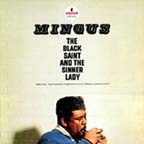 encompassed
through living in a society that calls itself sane.” It is a statement
of personal integrity and bold defiance in the face of the dominant
white culture, and it recalls Hughes’ ultimatum that, “If white people
are pleased we are glad. If they are not, it doesn’t matter. We know we
are beautiful. And ugly too.” encompassed
through living in a society that calls itself sane.” It is a statement
of personal integrity and bold defiance in the face of the dominant
white culture, and it recalls Hughes’ ultimatum that, “If white people
are pleased we are glad. If they are not, it doesn’t matter. We know we
are beautiful. And ugly too.”
Aware that
he has difficulty articulating—in words—the conflicted impulses behind
the music of "The Black Saint and the Sinner Lady," the composer asks
psychologist and friend Dr. Edmund Pollock to shed light on the artist
and this monumental work. Pollock quickly gets to the heart of the
matter, writing of Mingus, "His music is a call for acceptance, respect,
love, understanding, fellowship, freedom—a plea to change the evil in
man and to end hatred. The titles of this composition suggest the plight
of the black man and a plea to the white man to be aware. He seems to
state that the black man is not alone but all mankind must unite in
revolution against any society that restricts freedom and human rights."
A note of hope arises near the end of the piece, and Pollock offers a
cautious prediction about the composer, his music and his struggle to
function in a dysfunctional world, writing, “It must be emphasized that
Mr. Mingus is not yet complete, He is still in a process of change and
personal development. Hopefully the integration in society will keep
pace with his.”
As Pollock
foresaw, Mingus continued to develop as an artist, releasing a dozen
more recordings before his death at age 56 in January 1979, from
amyotrophic lateral sclerosis (Lou Gehrig’s disease). His music still
resonates more than 30 years later. Summarizing "Blues and Roots,"
Hentoff writes, “As this album powerfully affirms, Mingus’ music will
remain alive so long as there is life in the world.” In his immortal
recordings and their impact on countless composers, musicians, writers
and other artists, Mingus seems to echo the Hughes credo: “We build our
temples for tomorrow, strong as we know how, and we stand on top of the
mountain, free within ourselves.”
top |
|
Tomfoolery
Natural
disaster, death, youth, and music |
|
By Tom Ineck
LINCOLN, Neb.—Even in the best of times,
travel is a process of self-discovery.
In the midst of cataclysmic natural
disaster and the long-distance death of
a loved one, the lessons you learn can
assume epic proportions. For me, those
lessons usually involve the healing
power of music and the importance of
friends
![New Orleans resident and cousin Jerry Siefken with Tom Ineck [Photo by Mary Jane Gruba]](media/710NOJFJerryTom.jpg) and
family. Of course, you don’t have to
leave your home town to appreciate the
resilience of life, love and friendship.
Three recent events brought these
thoughts home. and
family. Of course, you don’t have to
leave your home town to appreciate the
resilience of life, love and friendship.
Three recent events brought these
thoughts home.
My wife and I arrived in New Orleans on
April 28 for Jazz Fest music, food and
fun. But just eight days earlier, the
Deepwater Horizon oil rig had exploded,
killing 11 people and causing the worst
oil spill in U.S. history. Already,
experts were predicting the immense
scale of ecological damage and economic
misery that would follow. With typical
fatalism, longtime New Orleans
residents, like my cousin Jerry Siefken,
took it in stride, mixing a healthy
distrust of authority with the sense
that life would go on. It was a lesson
they had learned many times over, most
recently in 2005 when Hurricane Katrina
nearly wiped the city off the map. And
what would help them get through the
dark days ahead? Music!
![Tom Ineck, Joe Phillips, Nikki Farrer and Kelly McKeen, friends for 40 years [Photo by Michelle Jensen]](media/710HealdsburgGang.jpg) In
early June I returned to Northern
California and the Healdsburg Jazz
Festival, where I had spent a week last
summer with friends who live near
Occidental. While we were in the middle
of a particularly profound performance
by Charlie Haden, Geri Allen and Ravi
Coltrane at the Raven Theater in
Healdsburg, I learned that my
brother-in-law Bob Doulas had died back
in Lincoln. I knew he was near death
when I left on the trip and had been in
touch with my sister for updates on his
condition. When the call came, my cell
phone began to vibrate. Oddly, it felt
like the passing of a spirit. What
helped me cope with that sad
realization? Friends and music! In
early June I returned to Northern
California and the Healdsburg Jazz
Festival, where I had spent a week last
summer with friends who live near
Occidental. While we were in the middle
of a particularly profound performance
by Charlie Haden, Geri Allen and Ravi
Coltrane at the Raven Theater in
Healdsburg, I learned that my
brother-in-law Bob Doulas had died back
in Lincoln. I knew he was near death
when I left on the trip and had been in
touch with my sister for updates on his
condition. When the call came, my cell
phone began to vibrate. Oddly, it felt
like the passing of a spirit. What
helped me cope with that sad
realization? Friends and music!
For the second consecutive year, the
Jazz in June concert series offered five
Tuesday evening concerts. They ran the
gamut from the straight-ahead jazz of
trumpeter Darryl White and his excellent
combo to the Latin lilt of Otro Mundo to
the sensuous vocals of Angela Hagenbach
to the New Orleans swagger of Jeff
![Brief chat with Bill Frisell (right) after his performanc at Healdsburg Jazz Festival [Photo by Kelly McKeen]](media/710HealdsburgFrisellMe.jpg) Newell’s
New-Trad Octet to the progressive guitar
work of Jerry Hahn. The last two were
especially delightful, allowing us to
bring friends of the Berman Music
Foundation back to Lincoln after an
absence of several years. Newell had not
performed here since 2006 and Hahn was
last here in 2005. Newell’s
New-Trad Octet to the progressive guitar
work of Jerry Hahn. The last two were
especially delightful, allowing us to
bring friends of the Berman Music
Foundation back to Lincoln after an
absence of several years. Newell had not
performed here since 2006 and Hahn was
last here in 2005.
Best of all, Newell and Hahn were able
to join us at BMF offices for
post-concert receptions. The entire
New-Trad ensemble partied with us until
midnight, and then ventured to the Zoo
Bar to sit in with the local Jazzocracy
band until closing. Hahn arrived alone,
but stayed for a couple of hours,
chatting about everything from the
foundation’s 15-year history to his own
50-year career as a performer, recording
artist and music educator.
Among other things, we revisited the
meteoric rise and fall of The Jerry Hahn
Brotherhood, the legendary quartet that
combined elements of jazz, rock and
![Jerry Hahn and Tom Ineck with an autographed copy of the rare Jerry Hahn Brotherhood LP. [Photo by Grace Sankey-Berman]](media/710Receptions10.jpg) r&b.
Hahn, bassist Mel Graves, and drummer
George Marsh had been gigging as a jazz
trio in the San Francisco Bay area in
the late 1960s when they were introduced
to the brilliant organist and vocalist
Mike Finnigan. Armed with a set of great
tunes by Lane Tietgen, Ornette Coleman’s
“Ramblin’” and a couple of originals by
Hahn, they recorded a single self-titled
recording on Columbia and toured behind
it until the record company promotion
fizzled and the money ran out. Left
behind are the memories of those lucky
few of us who attended a Brotherhood
concert. My opportunity came in July
1970 at the band’s Denver stop, a
performance also attended by a
19-year-old Bill Frisell, who I just saw
in June out in California. Serendipity. r&b.
Hahn, bassist Mel Graves, and drummer
George Marsh had been gigging as a jazz
trio in the San Francisco Bay area in
the late 1960s when they were introduced
to the brilliant organist and vocalist
Mike Finnigan. Armed with a set of great
tunes by Lane Tietgen, Ornette Coleman’s
“Ramblin’” and a couple of originals by
Hahn, they recorded a single self-titled
recording on Columbia and toured behind
it until the record company promotion
fizzled and the money ran out. Left
behind are the memories of those lucky
few of us who attended a Brotherhood
concert. My opportunity came in July
1970 at the band’s Denver stop, a
performance also attended by a
19-year-old Bill Frisell, who I just saw
in June out in California. Serendipity.
It seemed that talking about those
events of 40 years ago allowed both Hahn
and me to revisit our youth and an
exciting period in American pop culture.
What was the common bond? Music, of
course!
top |
|
|
|
Editor’s Note:
At your request, we will mail a printed version
of the newsletter. The online newsletter also is available at this
website in PDF format for printing. Just click here: Newsletter
|
|